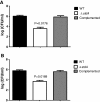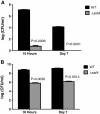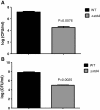Role of StdA in adhesion of Salmonella enterica serovar Enteritidis phage type 8 to host intestinal epithelial cells
- PMID: 24367906
- PMCID: PMC3877977
- DOI: 10.1186/1757-4749-5-43
Role of StdA in adhesion of Salmonella enterica serovar Enteritidis phage type 8 to host intestinal epithelial cells
Abstract
Background: Salmonella is often implicated in foodborne outbreaks, and is a major public health concern in the United States and throughout the world. Salmonella enterica serovar Enteritidis (SE) infection in humans is often associated with the consumption of contaminated poultry products. Adhesion to epithelial cells in the intestinal mucosa is a major pathogenic mechanism of Salmonella in poultry. Transposon mutagenesis identified stdA as a potential adhesion mutant of SE. Therefore, we hypothesize StdA plays a significant role in adhesion of SE to the intestinal mucosa of poultry.
Methods and results: To test our hypothesis, we created a mutant of SE in which stdA was deleted. Growth and motility were assayed along with the in vitro and in vivo adhesion ability of the ∆stdA when compared to the wild-type SE strain. Our data showed a significant decrease in motility in ∆stdA when compared to the wild-type and complemented strain. A decrease in adhesion to intestinal epithelial cells as well as in the small intestine and cecum of poultry was observed in ∆stdA. Furthermore, the lack of adhesion correlated to a defect in invasion as shown by a cell culture model using intestinal epithelial cells and bacterial recovery from the livers and spleens of chickens.
Conclusions: These studies suggest StdA is a major contributor to the adhesion of Salmonella to the intestinal mucosa of poultry.
Figures





Similar articles
-
Role of the flagellar basal-body protein, FlgC, in the binding of Salmonella enterica serovar Enteritidis to host cells.Curr Microbiol. 2014 May;68(5):621-8. doi: 10.1007/s00284-014-0521-z. Epub 2014 Jan 14. Curr Microbiol. 2014. PMID: 24420330
-
Salmonella enterica serovar enteritidis pathogenicity island 1 is not essential for but facilitates rapid systemic spread in chickens.Infect Immun. 2009 Jul;77(7):2866-75. doi: 10.1128/IAI.00039-09. Epub 2009 Apr 13. Infect Immun. 2009. PMID: 19364835 Free PMC article.
-
Intestinal epithelial responses to Salmonella enterica serovar Enteritidis: effects on intestinal permeability and ion transport.Poult Sci. 2012 Nov;91(11):2949-57. doi: 10.3382/ps.2012-02448. Poult Sci. 2012. PMID: 23091155
-
Epidemiology and control of egg-associated Salmonella enteritidis in the United States of America.Rev Sci Tech. 1997 Aug;16(2):542-53. doi: 10.20506/rst.16.2.1045. Rev Sci Tech. 1997. PMID: 9501367 Review.
-
The vertical transmission of Salmonella Enteritidis in a One-Health context.One Health. 2022 Dec 5;16:100469. doi: 10.1016/j.onehlt.2022.100469. eCollection 2023 Jun. One Health. 2022. PMID: 36507074 Free PMC article. Review.
Cited by
-
A candidate glycoconjugate vaccine induces protective antibodies in the serum and intestinal secretions, antibody recall response and memory T cells and protects against both typhoidal and non-typhoidal Salmonella serovars.Front Immunol. 2024 Jan 9;14:1304170. doi: 10.3389/fimmu.2023.1304170. eCollection 2023. Front Immunol. 2024. PMID: 38264668 Free PMC article.
-
Genomic Comparison of Non-Typhoidal Salmonella enterica Serovars Typhimurium, Enteritidis, Heidelberg, Hadar and Kentucky Isolates from Broiler Chickens.PLoS One. 2015 Jun 17;10(6):e0128773. doi: 10.1371/journal.pone.0128773. eCollection 2015. PLoS One. 2015. PMID: 26083489 Free PMC article.
References
LinkOut - more resources
Full Text Sources
Other Literature Sources

